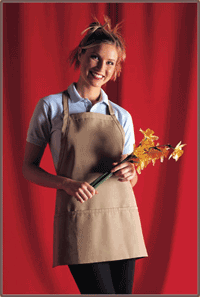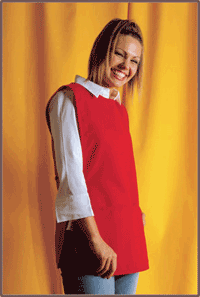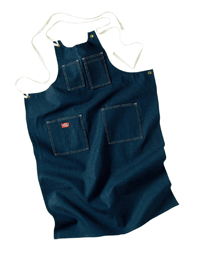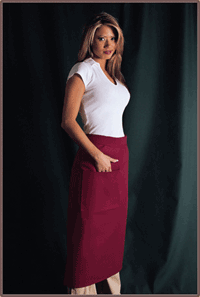|
By Mark Rowh Would the average person characterize an apron as a uniform? At first thought, the answer might be no since this handy item consists of just a single garment. But in a broader sense, as those in the industry realize, an apron can definitely function as a uniform. Take a dress, or a pair of slacks and a shirt, and then cover with an apron. Presto! You have an instant uniform. From restaurants to hardware stores and a slew of other settings, all types of workers employ aprons to form the crux of a uniform. At the same time, aprons protect the clothing underneath, serve as walking storage space and otherwise make the work day more efficient. In the process, the amount of bang for the buck for apron users is impressive. The apron is the most universal uniform out there now, says Scott Dopke, general manager of Republic Uniforms, a distributor for The Apron Works. It protects the clothes, can advertise for the client and is very functional. In fact, designers of aprons, as well as those who purchase and wear them, have been remarkably creative in making use of these seemingly simple garments. Aprons serve the two major purposes of protecting your clothes from stains and providing a place to store essentials, says Jeremy Hall, vice president for sales and marketing for Daystar Apparel. These are areas of need, not just want. Many companies also turn the apron into part of their uniform, mainly classified as want, not need. But it is very encouraging to know we are producing garments that are needed in the industry that makes for great job security for all of us! In the workplace, aprons fulfill any number of functions. Nurses, welders, retail clerks, cooks, domestic workers, waitresses, barbers and many others make use of some type of apron. Typically, the main purpose is protecting the wearer (or more typically, his or her clothes) from stains or other damage, or from contamination. In some cases, an apron is used primarily to offer a convenient place for carrying tools or supplies while keeping hands free. The familiar carpenters apron, for example, allows workers to climb or move about freely without the need to carry a heavy tool box. Less commonly, aprons may play important health roles. Those lined with lead, for example, are used to shield patients, health care professionals or researchers from x-rays or other radiation. In the home, aprons can be used not only in the kitchen but for outdoor grilling, cleaning or other tasks, as well as during entertaining. For the latter, decorative elements may be the most important features. It is in the workplace, however, that aprons have the most to offer, according to industry insiders. In addition to their practicality, aprons can be an effective way to project a desired image. Aprons offer a uniform look for any establishment, says Jackie Barker, vice president of sales and marketing for ERB Industries. They can help create confidence for the consumer to shop with the establishment. Apron designs offer a surprising level of variety. Some feature a single large pocket, for instance, while others offer two or three pockets or more. Pockets may be deep or shallow, slanted or straight, lined or unlined. Some are positioned in full view directly across the front or doubled up so that two exterior pockets conceal two others immediately behind them. The alignment of some is designed to promote easy access, while others foster security so that contents or money may not be easily removed. Some are ideal for holding tools or scissors, while others are better suited for smaller items ranging from spools of thread to business cards. And of course, some are purely decorative. Overall design style, from length to the manner in which they are tied, also varies widely. Materials also offer varied choices. Cotton continues to be especially popular, with linen, polyester and other fabrics also common. Leather and rubberized models also serve special needs.
LONG HISTORY The history of the apron is a long one. Aprons have emerged in many cultures, with one of the earliest mentions being the Biblical story of the Garden of Eden. When Adam and Eve discovered they were naked, they fashioned aprons from fig leaves. Other uses over the centuries have been less flamboyant, but the aprons simplicity has held appeal for many generations. Aprons became especially prominent in the Middle Ages, when European craftsmen used them as everyday garments. The tradition continued though the Industrial Revolution and into modern times, with women wearing them during domestic service and men employing their own versions in roles such as fishing, meat-cutting, blacksmithing, gardening and butlery. Until just a few decades ago, few people had extensive wardrobes, and women typically wore the few dresses they owned repeatedly before cleaning them. By covering themselves with aprons while cooking or taking care of other domestic chores, they could protect their clothing from dirt and stains and extend use. In 20th century America, aprons were a standard of housewives, both in real life and in the media, until the rise of the womens movement. In the 1960s and 70s, changing social standards relegated aprons to largely outdated symbols where womens roles were concerned. But their applications in the work place have continued unabated. VARIED USES Even a partial list of contemporary apron users can be revealing. Our customers are chefs, waiters, bartenders, dish washers, busboys, housekeeping, maids, butchers, grocery clerks, car wash attendants, assembly line workers, carpenters, landscapers, gardeners, craftsman and homemakers, Dopke says. Our aprons also serve as gifts, art, giveaways, advertising, samplers and promotional items. Not only do aprons tend to be simple in design, but they offer a surprising degree of versatility. Aprons are one of the most versatile products in the industry and are seen in almost every market, Hall says. During TV commercial breaks, one will notice that many of the advertisements will show someone wearing an apron. Aprons are worn obviously in kitchens and by wait staff, but range everywhere from street peddlers to White House staff. Along with their more ordinary applications, these popular products have all kinds of specialized uses. For example, end users of Daystars products include caddies who wear cobbler aprons during golf tournaments, and dog trainers who employ a short version of a tunic for training purposes. Aprons are also available that include hidden compartments for hiding valuables and cash. I have seen our aprons tied around the backs of car seats to provide drivers a place to store their stuff, Hall says. I have also seen our bib aprons folded in half to create a waist apron, creating a two-in-one apron style. Barker notes that usage varies widely from establishment to establishment. The traditional user is a retail shop or restaurant, she says. The breadth of use goes deeper, including floral shops, day care centers, artists and home wearers, among others. Barker says that the companys Fame Fabrics line coordinates well with its sister line, ERB Safety. Fames aprons work well within janitorial/sanitary and maintenance areas, she says. This is especially true when combined with protective eyewear and gloves or any of the other safety products offered in the line. In retail or food service applications, aprons can serve as attention-getters. One stand out for us was a screen printed bib apron, Barker says. It had a corporate logo and a picture of a waitresss body and was sold as a gift pack with other products from the restaurant. Lets just say a lot of wings were sold. The potential to enhance marketing or promotional efforts brings added appeal. We always try to get our restaurant clients to embroider their logo on the aprons to enhance the look of their staff and the restaurant, Dopke says. Aprons can be used in every business not just to protect clothing, but also for promotion. You can advertise on an apron or make it a piece of artwork. They also make nice giveaways. With a solid history and an equally promising future, aprons seem to be a staple among uniforms. No matter what the purpose, these versatile garments can be expected to continue playing their role. |
|
| Above story first appeared in MADE TO MEASURE Magazine, Spring & Summer 2005 issue. All rights reserved. Photos appear by special permission. | |
| Halper Publishing Company 633 Skokie Blvd, #490 Northbrook, IL 60062 (847) 780-2900 Fax (224) 406-8850 [email protected] |
|














